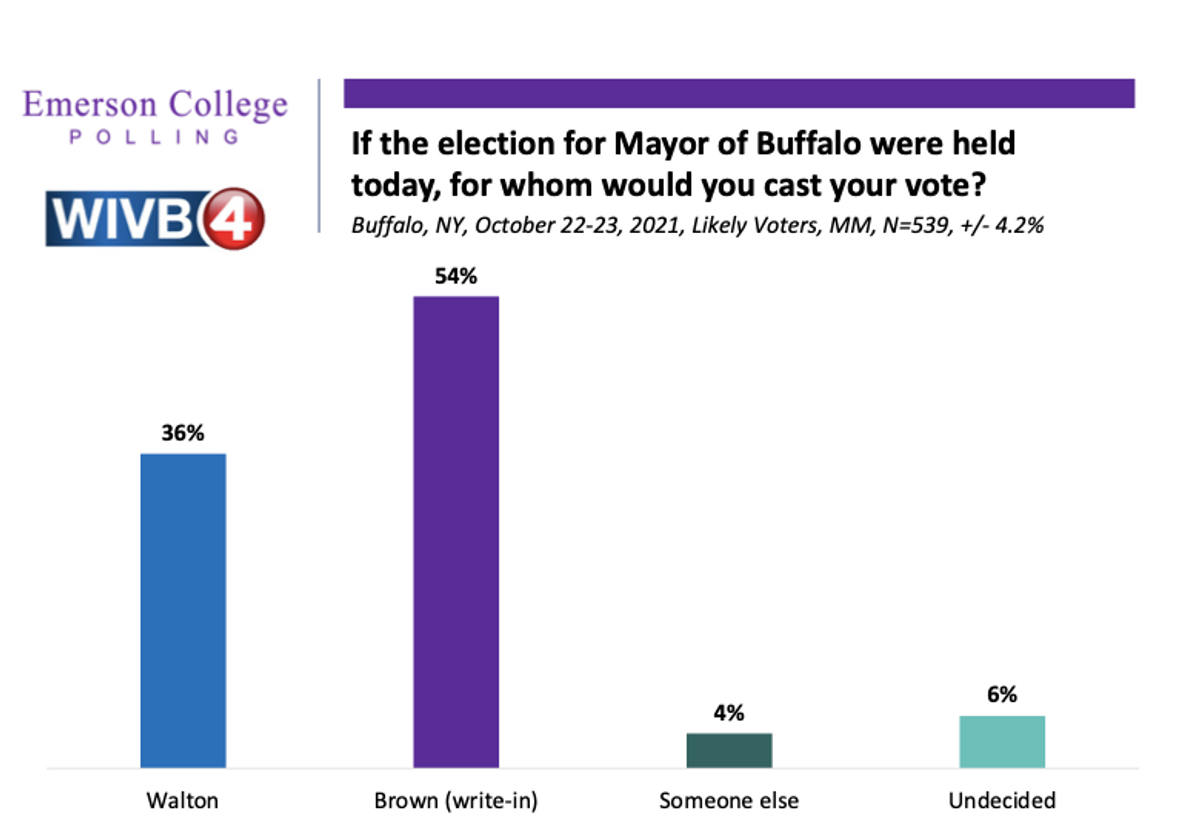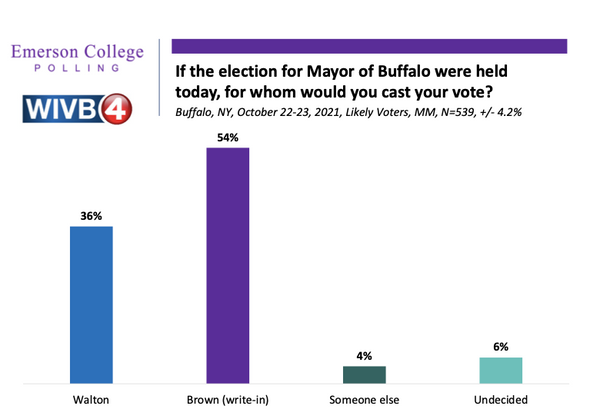The latest Emerson College/WIVB poll finds incumbent Mayor Byron Brown at 54%, 18 points ahead of India Walton, the Democratic nominee, who is at 36%. Brown is up 4 points from August. Six percent (6%) of voters are undecided, and 4% plan to vote for someone else.

When presented with the question of who they were planning to vote for, respondents were all given Walton’s name, an undecided option, and an option for “someone else”. Of those who responded “someone else”, they were required to either write-in Brown’s name (SMS-to-web), or speak it into the phone (IVR).
Brown is leading among Democrats (50% to 41%), Republicans (82% to 8%), and Independents (54% to 35%). Brown is leading among women (65% to 31%), LatinX voters (68% to 14%), White voters (64% to 31%), and all age groups over 35 years. Walton is leading among Black voters (54% to 37%), college graduates (46% to 40%), and the 18-34 age group (51% to 45%).
Democratic voters are split between planning to vote for Brown (50%) or Walton (41%), despite Walton winning the primary by 7 percentage points. This suggests that Brown may have a base that did not come out to vote in the primary, but is now tuning in for the general election. Of our surveyed voters, 43% did not vote in the primary.
When asked if Mayor Brown should have continued his campaign after losing the Democratic primary, a majority (58%) support his decision to run a write-in campaign, while 32% think he should have discontinued his campaign, and 10% are unsure.
When asked their opinion of the candidates, a majority (52%) of voters said their opinion of Walton has worsened since the primary. Opinion on Brown is split, with 32% of voters saying their opinion of Brown has improved, 36% saying their opinion has worsened, and 32% saying their opinion has stayed the same.
Issues
Voters were asked about what issues they believe should be the next mayor’s first priority, regardless of who they support. Twenty-one percent (21%) want a focus on crime, 16% on education, and 16% on development. Voters were also asked about housing (11%), police reform (10%), jobs (9%), homelessness (4%), healthcare (3%), and Covid-19 (2%), with 9% of voters supporting something else.
Walton voters prioritized police reform (21%), housing (20%), and education/schools (15%), while Brown voters said crime (33%), development (18%), and education/schools (18%).
Voters are split on whether they would elect someone who identifies as a Democratic socialist into office, with 38% saying yes, 45% saying no, and 17% unsure or no opinion.
A plurality (46%) of voters support term limits for Buffalo mayor, with 34% in opposition, and 20% unsure.
When asked about the Buffalo Police Department, a plurality of voters (42%) believe the budget should increase, while 31% say the budget should stay the same, 19% say it should be decreased, and 8% are unsure.
A plurality (47%) support gradually redirecting police funding toward increasing the number of social workers, drug counselors and mental health experts responsible for responding to non-violent emergencies. Thirty-six percent (36%) are opposed, and 16% are unsure.
Voters support building a new Buffalo Bills stadium, at 63%, while 23% believe the current stadium should be renovated, and 14% say that nothing should be done, even if that means the Bills leave Buffalo. Regarding the potential location of a new stadium, the majority (69%) say it should be built in the city of Buffalo. Twenty-six percent (26%) want the new stadium to be built outside of Buffalo, in Orchard Park, and 5% say it should be built in another location.
Caller ID
The Buffalo Emerson College/WIVB-4 poll was conducted October 22-23, 2021. The sample consisted of Buffalo likely voters, n=539, with a margin of error (MOE) of +/- 4.2 percentage points. The data sets were weighted by gender, age, education, race, and party affiliation. It is important to remember that subsets based on gender, age, party breakdown, ethnicity, and region carry with them higher margins of error, as the sample size is reduced. Data was collected via a cellphone sample using SMS-to-web, and a landline sample using IVR.


